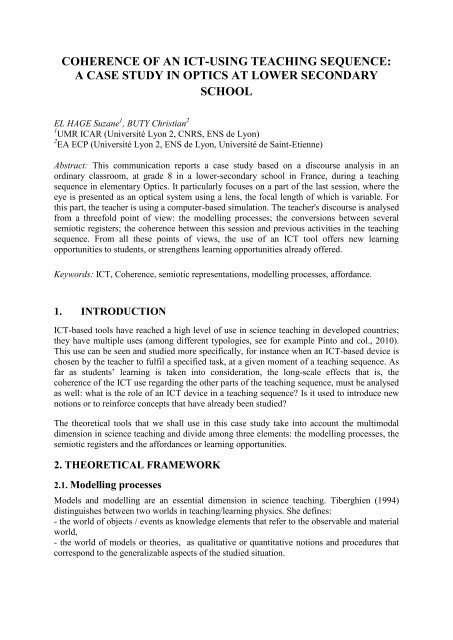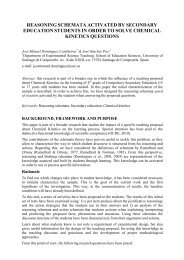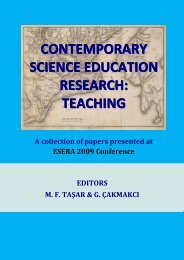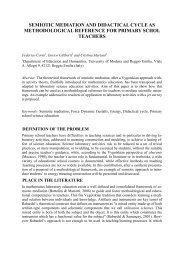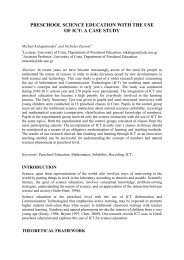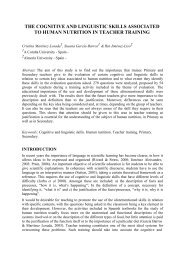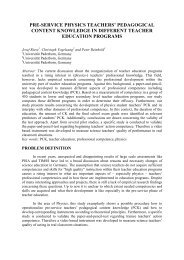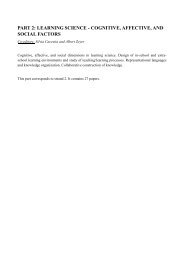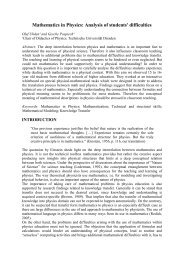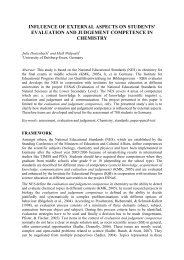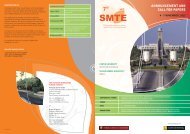a case study in optics at lower secondary school - ESERA
a case study in optics at lower secondary school - ESERA
a case study in optics at lower secondary school - ESERA
Create successful ePaper yourself
Turn your PDF publications into a flip-book with our unique Google optimized e-Paper software.
COHERENCE OF AN ICT-USING TEACHING SEQUENCE:<br />
A CASE STUDY IN OPTICS AT LOWER SECONDARY<br />
SCHOOL<br />
EL HAGE Suzane 1 , BUTY Christian 2<br />
1 UMR ICAR (Université Lyon 2, CNRS, ENS de Lyon)<br />
2 EA ECP (Université Lyon 2, ENS de Lyon, Université de Sa<strong>in</strong>t-Etienne)<br />
Abstract: This communic<strong>at</strong>ion reports a <strong>case</strong> <strong>study</strong> based on a discourse analysis <strong>in</strong> an<br />
ord<strong>in</strong>ary classroom, <strong>at</strong> grade 8 <strong>in</strong> a <strong>lower</strong>-<strong>secondary</strong> <strong>school</strong> <strong>in</strong> France, dur<strong>in</strong>g a teach<strong>in</strong>g<br />
sequence <strong>in</strong> elementary Optics. It particularly focuses on a part of the last session, where the<br />
eye is presented as an optical system us<strong>in</strong>g a lens, the focal length of which is variable. For<br />
this part, the teacher is us<strong>in</strong>g a computer-based simul<strong>at</strong>ion. The teacher's discourse is analysed<br />
from a threefold po<strong>in</strong>t of view: the modell<strong>in</strong>g processes; the conversions between several<br />
semiotic registers; the coherence between this session and previous activities <strong>in</strong> the teach<strong>in</strong>g<br />
sequence. From all these po<strong>in</strong>ts of views, the use of an ICT tool offers new learn<strong>in</strong>g<br />
opportunities to students, or strengthens learn<strong>in</strong>g opportunities already offered.<br />
Keywords: ICT, Coherence, semiotic represent<strong>at</strong>ions, modell<strong>in</strong>g processes, affordance.<br />
1. INTRODUCTION<br />
ICT-based tools have reached a high level of use <strong>in</strong> science teach<strong>in</strong>g <strong>in</strong> developed countries;<br />
they have multiple uses (among different typologies, see for example P<strong>in</strong>to and col., 2010).<br />
This use can be seen and studied more specifically, for <strong>in</strong>stance when an ICT-based device is<br />
chosen by the teacher to fulfil a specified task, <strong>at</strong> a given moment of a teach<strong>in</strong>g sequence. As<br />
far as students’ learn<strong>in</strong>g is taken <strong>in</strong>to consider<strong>at</strong>ion, the long-scale effects th<strong>at</strong> is, the<br />
coherence of the ICT use regard<strong>in</strong>g the other parts of the teach<strong>in</strong>g sequence, must be analysed<br />
as well: wh<strong>at</strong> is the role of an ICT device <strong>in</strong> a teach<strong>in</strong>g sequence? Is it used to <strong>in</strong>troduce new<br />
notions or to re<strong>in</strong>force concepts th<strong>at</strong> have already been studied?<br />
The theoretical tools th<strong>at</strong> we shall use <strong>in</strong> this <strong>case</strong> <strong>study</strong> take <strong>in</strong>to account the multimodal<br />
dimension <strong>in</strong> science teach<strong>in</strong>g and divide among three elements: the modell<strong>in</strong>g processes, the<br />
semiotic registers and the affordances or learn<strong>in</strong>g opportunities.<br />
2. THEORETICAL FRAMEWORK<br />
2.1. Modell<strong>in</strong>g processes<br />
Models and modell<strong>in</strong>g are an essential dimension <strong>in</strong> science teach<strong>in</strong>g. Tiberghien (1994)<br />
dist<strong>in</strong>guishes between two worlds <strong>in</strong> teach<strong>in</strong>g/learn<strong>in</strong>g physics. She def<strong>in</strong>es:<br />
- the world of objects / events as knowledge elements th<strong>at</strong> refer to the observable and m<strong>at</strong>erial<br />
world,<br />
- the world of models or theories, as qualit<strong>at</strong>ive or quantit<strong>at</strong>ive notions and procedures th<strong>at</strong><br />
correspond to the generalizable aspects of the studied situ<strong>at</strong>ion.
From this epistemological po<strong>in</strong>t of view, physics teach<strong>in</strong>g can be considered fundamentally as<br />
a m<strong>at</strong>ter of modell<strong>in</strong>g processes, of establish<strong>in</strong>g mean<strong>in</strong>gful l<strong>in</strong>ks between “the world of<br />
objects and events” and “the world of theories and models”.<br />
Very often, ICT-based tools represent models of empirical realities, and one of the tasks of<br />
the teacher is to make this st<strong>at</strong>us clear for the students. For <strong>in</strong>stance, <strong>in</strong> our <strong>case</strong>, the software<br />
used <strong>in</strong> physics (Cabri-Géomètre 1 ) obeys the rules of physics and its represent<strong>at</strong>ions belong to<br />
the world of theories / models.<br />
2.2. Semiotic registers (semiotic represent<strong>at</strong>ions)<br />
Science classroom discourse is a particular one. It is multimodal <strong>in</strong> pr<strong>in</strong>ciple (Lemke, 1998)<br />
and uses several semiotic registers. Duval (1995) def<strong>in</strong>es the semiotic registers <strong>in</strong> the<br />
follow<strong>in</strong>g way: "they are the productions made by the use of signs (utterances <strong>in</strong> n<strong>at</strong>ural<br />
language, algebraic formulas, graphs, geometrical figures…)".<br />
When us<strong>in</strong>g ICT <strong>in</strong> science classroom, many modes of represent<strong>at</strong>ion, many “semiotic<br />
register” are used <strong>in</strong> the classroom discourse; the dynamic graphical represent<strong>at</strong>ions, which<br />
are the core of most ICT-based tools, must be articul<strong>at</strong>ed with n<strong>at</strong>ural language (words and<br />
gestures as well), or st<strong>at</strong>ic graphical represent<strong>at</strong>ions (draw<strong>in</strong>gs or schemas on the blackboard,<br />
for example), or m<strong>at</strong>hem<strong>at</strong>ical symbolism.<br />
Duval def<strong>in</strong>es some semiotics registers <strong>in</strong> m<strong>at</strong>hem<strong>at</strong>ics educ<strong>at</strong>ion. We take <strong>in</strong> the follow<strong>in</strong>g<br />
semiotic registers very often used <strong>in</strong> teach<strong>in</strong>g physics:<br />
- The register of n<strong>at</strong>ural language: it is the primary tool used before and / or dur<strong>in</strong>g the<br />
acquisition of scientific vocabulary. This register is flexible th<strong>at</strong> is, used <strong>in</strong> the world of<br />
objects / events, the world of theories / models and to make a l<strong>in</strong>k between the two worlds.<br />
- The register th<strong>at</strong> conta<strong>in</strong>s draw<strong>in</strong>gs, diagrams, and graphs:<br />
a- a draw<strong>in</strong>g is an "exact represent<strong>at</strong>ion of the shape of an object" (Davy & Doul<strong>in</strong>, 1991);<br />
b- a schema is a represent<strong>at</strong>ion of a referent. It can be non-figur<strong>at</strong>ive and figur<strong>at</strong>ive. A<br />
figur<strong>at</strong>ive schema refers to someth<strong>in</strong>g sensible, visual and perceived while a non-figur<strong>at</strong>ive<br />
schema design<strong>at</strong>es a mental referent. (Estivales, 2003, page 56).<br />
2.3. Affordance versus Learn<strong>in</strong>g opportunity<br />
The psychologist James Gibson proposed the term “affordance”, <strong>in</strong> his ecological theory of<br />
perception (Gibson, 1979). He noted th<strong>at</strong> the affordance depends on <strong>in</strong>teractions between the<br />
animal and its environment: “affordances as wh<strong>at</strong> the environment offers the organism”.<br />
In the field of ICT-based science educ<strong>at</strong>ion, Webb (2005) expresses a def<strong>in</strong>ition for the notion<br />
of affordance <strong>in</strong>herited from Gibson: “In an ICT-supported learn<strong>in</strong>g environment affordances<br />
are provided by <strong>in</strong>teractions between the hardware, software, other resources, teachers and<br />
other students” (Webb 2005, p.707).<br />
We consider as mean<strong>in</strong>gful to <strong>in</strong>troduce a dist<strong>in</strong>ction between two phases of teacher’s activity<br />
when implement<strong>in</strong>g an ICT-based activity <strong>in</strong> the class, regard<strong>in</strong>g the coherence of the<br />
teach<strong>in</strong>g sequence and the effects on learn<strong>in</strong>g. This dist<strong>in</strong>ction is a consequence of our sociocultural<br />
po<strong>in</strong>t of view on science learn<strong>in</strong>g, which gives a key role to social <strong>in</strong>teractions <strong>in</strong> the<br />
construction of knowledge.<br />
1 www.cabri.com
When a teacher plans to use an ICT-based tool <strong>in</strong> a teach<strong>in</strong>g session, he or she first chooses<br />
the software (or special functionalities of the software), depend<strong>in</strong>g on the <strong>school</strong> equipment,<br />
on the start<strong>in</strong>g po<strong>in</strong>t of the students, on the teach<strong>in</strong>g aims, etc. The teacher also foresees the<br />
way he or she will play the scene. We keep the term “affordances” for this set of<br />
characteristics th<strong>at</strong> are planned before the session beg<strong>in</strong>s.<br />
Dur<strong>in</strong>g the activity itself <strong>in</strong> the class, the <strong>in</strong>teractions can widely modify wh<strong>at</strong> has been<br />
planned. When we analyse the classroom discourse, we f<strong>in</strong>d evidences of unpredicted<br />
suggestions by students, or unforeseen procedures (right or wrong) they use, which devi<strong>at</strong>es<br />
the knowledge flow <strong>in</strong> the classroom discourse and activity, and consequently which can<br />
activ<strong>at</strong>e or <strong>in</strong>hibit previously organized affordances. We call learn<strong>in</strong>g opportunities the<br />
affordances th<strong>at</strong> have been effectively offered to students dur<strong>in</strong>g the classroom <strong>in</strong>teractions;<br />
students can c<strong>at</strong>ch or not these opportunities, this is another question ask<strong>in</strong>g for different<br />
methodologies.<br />
2.4. L<strong>in</strong>ks between the theoretical tools<br />
These four k<strong>in</strong>ds of theoretical tools are relevant with our purpose to analyse the coherence<br />
between the moments when the teacher uses ICT-based activities, and other moments of the<br />
sequence. These two k<strong>in</strong>ds of activities can be <strong>at</strong> different modell<strong>in</strong>g levels, on one hand, and<br />
use different types of represent<strong>at</strong>ions on the other hand. Moreover, the term of affordance, as<br />
def<strong>in</strong>ed by Webb <strong>in</strong> the cited sentence, is essentially an <strong>in</strong>tegr<strong>at</strong>ed one, <strong>in</strong>sist<strong>in</strong>g on the<br />
various facets th<strong>at</strong> constitute an affordance.<br />
3. RESEARCH QUESTION<br />
Tak<strong>in</strong>g <strong>in</strong>to account the previous theoretical elements, the questions <strong>in</strong> this <strong>study</strong> are: how<br />
does the use by the teacher of an ICT-based tool construct the coherence of a teach<strong>in</strong>g<br />
sequence? How does the use by the teacher of an ICT-based tool offer new learn<strong>in</strong>g<br />
opportunities to students, <strong>in</strong> the flow of classroom discourse?<br />
4. METHODOLOGY<br />
We have filmed a male physics teacher <strong>at</strong> the <strong>lower</strong> <strong>secondary</strong> <strong>school</strong> <strong>in</strong> France, dur<strong>in</strong>g a<br />
complete teach<strong>in</strong>g sequence. This sequence consists <strong>in</strong> six activities, each session last<strong>in</strong>g one<br />
hour and a half. This sequence 2 is a research-based one, as it has been elabor<strong>at</strong>ed <strong>in</strong> a jo<strong>in</strong>t<br />
group <strong>in</strong>volv<strong>in</strong>g a researcher and several teachers.<br />
We have <strong>in</strong>dexed our video d<strong>at</strong>a of the entire sequence <strong>in</strong> a table (script). We identify the<br />
sessions where the teacher used the software Cabri <strong>in</strong> the sequence: two times. We have<br />
chosen to present here the analysis of a s<strong>in</strong>gle use of Cabri (the second one, May 25).<br />
We particularly looked <strong>at</strong> the moments when the teacher used the software, and we<br />
transcribed these moments. In the discourse of the teacher we searched all the <strong>in</strong>dic<strong>at</strong>ors<br />
rel<strong>at</strong><strong>in</strong>g to the activities earlier <strong>in</strong> the sequence.<br />
We present below (table 1) the “script” of the sequence <strong>in</strong>clud<strong>in</strong>g moments where the teacher<br />
used the software.<br />
D<strong>at</strong>e<br />
the<br />
of<br />
Number of<br />
the activity<br />
Learn<strong>in</strong>g objective <strong>in</strong>dic<strong>at</strong>ed <strong>at</strong> the<br />
beg<strong>in</strong>n<strong>in</strong>g of each activity<br />
Content of the activity<br />
2 See the current version <strong>at</strong> http://pegase.<strong>in</strong>rp.fr/theme.php?rubrique=1&id_theme=57
session<br />
2010_04<br />
_06<br />
Activity 1<br />
1. Recognize the different types of<br />
lenses.<br />
1. The students work <strong>in</strong> pairs to f<strong>in</strong>d among four lenses, which of them can<br />
serve as a magnify<strong>in</strong>g glass. The str<strong>at</strong>egy consists <strong>in</strong> look<strong>in</strong>g through the lenses.<br />
Activity 2<br />
2. Understand the effects of a<br />
converg<strong>in</strong>g lens <strong>in</strong> terms of <strong>optics</strong>.<br />
2. The teacher <strong>in</strong>troduces the terms diverg<strong>in</strong>g and converg<strong>in</strong>g lenses.<br />
2010_05<br />
_11<br />
Cabri<br />
(addition)<br />
Modell<strong>in</strong>g a converg<strong>in</strong>g/diverg<strong>in</strong>g beam of light after pass<strong>in</strong>g through a<br />
converg<strong>in</strong>g/diverg<strong>in</strong>g lens.<br />
Activity 3 3. Show th<strong>at</strong> the energy is<br />
concentr<strong>at</strong>ed <strong>at</strong> the focus of the<br />
converg<strong>in</strong>g lens for sources situ<strong>at</strong>ed <strong>at</strong><br />
the <strong>in</strong>f<strong>in</strong>ite.<br />
3. The students carry out experiments us<strong>in</strong>g a thermometer, a converg<strong>in</strong>g lens, a<br />
screen and a lamp. Students place the lamp as a light source followed by a<br />
converg<strong>in</strong>g lens. They measure the temper<strong>at</strong>ure of the light spot formed on a<br />
screen as they move it from the lens.<br />
2010_05<br />
_18<br />
Activity 4<br />
4. Show th<strong>at</strong> some specified condition<br />
is necessary to obta<strong>in</strong> an image .<br />
4. The students send the light of the lamp on a slide with the letter P. The light<br />
passes through a fixed converg<strong>in</strong>g lens. Students move the screen ( backwards<br />
and forwards from the lens) to obta<strong>in</strong> an image.<br />
Activity 5<br />
5. Understand the vision mechanism<br />
from the po<strong>in</strong>t of view of <strong>optics</strong>.<br />
5. The students establish the correspondence between the terms mentioned <strong>in</strong><br />
the draw<strong>in</strong>g of the eye (figure 1) and the follow<strong>in</strong>g words <strong>in</strong> the text: diaphragm,<br />
converg<strong>in</strong>g lens and screen.<br />
2010_05-<br />
25<br />
Cabri<br />
(addition)<br />
Correspondence between the elements of the eye <strong>in</strong> a schema and a draw<strong>in</strong>g.<br />
Convergence of the rays pass<strong>in</strong>g through a lens when they come from an object<br />
<strong>at</strong> a f<strong>in</strong>ite distance or an <strong>in</strong>f<strong>in</strong>ite one.<br />
Explan<strong>at</strong>ion of the accommod<strong>at</strong>ion phenomenon.<br />
Activity 6<br />
6. The corrective lenses for the eye<br />
defects.<br />
6. Correction of eye defects.<br />
Table 1: Script of the sequence titled “lens” (grade 8). The use of Cabri-files th<strong>at</strong> has been analysed took<br />
place on May 25 (bold characters).<br />
It was not planned to use Cabri-Géomètre <strong>in</strong> the sequence. Th<strong>at</strong> is why we have not<br />
completed the learn<strong>in</strong>g objective on the correspond<strong>in</strong>g l<strong>in</strong>es. The teacher was proposed to use<br />
Cabri files <strong>in</strong> this sequence by one of the authors, as they may facilit<strong>at</strong>e the understand<strong>in</strong>g of<br />
the modell<strong>in</strong>g processes by the students.<br />
5. ANALYSIS<br />
We present the results of analysis accord<strong>in</strong>g to each theoretical framework.<br />
5.1. Analysis <strong>in</strong> terms of modell<strong>in</strong>g processes<br />
5.1.a. Analysis of the files realised under Cabri Geomètre<br />
Cabri was used to model the convergence of light rays after pass<strong>in</strong>g through a converg<strong>in</strong>g<br />
lens. On this file, the teacher has the possibility to choose and modify the loc<strong>at</strong>ion of the<br />
object (f<strong>in</strong>ite distance, <strong>in</strong>f<strong>in</strong>ite distance) from the lens.<br />
These Cabri files obey to the laws of Optics, and the represent<strong>at</strong>ion obta<strong>in</strong>ed by Cabri refer to<br />
the world of theories / models.<br />
Nevertheless there is a difference between the k<strong>in</strong>d of represent<strong>at</strong>ion adopted by the Cabrifiles<br />
and the conventional represent<strong>at</strong>ional rules of Optics: <strong>in</strong> Cabri-files rays are represented<br />
by l<strong>in</strong>es without arrows, when optical rays carry arrows to <strong>in</strong>dic<strong>at</strong>e the direction of light<br />
propag<strong>at</strong>ion.<br />
5.1.b. Teacher’s discourse analysis dur<strong>in</strong>g the session
The teacher’s discourse allows us hypothesis<strong>in</strong>g th<strong>at</strong> the teacher aimed <strong>at</strong> mak<strong>in</strong>g a l<strong>in</strong>k<br />
between the two worlds. We base this <strong>in</strong>terpret<strong>at</strong>ion on the observed identific<strong>at</strong>ion of some<br />
elements of the world of objects and events (the crystall<strong>in</strong>e lens, the pupil, the ret<strong>in</strong>a, all<br />
specified by the "draw<strong>in</strong>g", figure 1) to correspond<strong>in</strong>g elements of the world of theories and<br />
models: the lens, the open<strong>in</strong>g <strong>in</strong> the square, the screen on the bottom of the square (figure 2).<br />
In his discourse, the teacher tried to expla<strong>in</strong> a phenomenon of everyday life (the<br />
accommod<strong>at</strong>ion) through a physical model. He suggested the situ<strong>at</strong>ion belong<strong>in</strong>g to the world<br />
of objects / events for students (“Probably you noticed it when you are read<strong>in</strong>g your textbook<br />
or a book, and you look <strong>at</strong> suddenly someth<strong>in</strong>g far from you” ) and then produced his<br />
explan<strong>at</strong>ion.<br />
Figure 1: st<strong>at</strong>ic represent<strong>at</strong>ion of an eye.<br />
Figure 2: dynamic represent<strong>at</strong>ion of an eye, from a physics<br />
po<strong>in</strong>t of view; represent<strong>at</strong>ion obta<strong>in</strong>ed by Cabri software;<br />
<strong>case</strong> of an object <strong>at</strong> an <strong>in</strong>f<strong>in</strong>ite distance from the eye.<br />
5.2. Analysis <strong>in</strong> terms of semiotic registers<br />
The teacher made explicit for students the difference between two semiotic registers: the<br />
graphic represent<strong>at</strong>ion and the draw<strong>in</strong>g (say<strong>in</strong>g for example: you see here is a schema, it is a<br />
schem<strong>at</strong>ic represent<strong>at</strong>ion, not a draw<strong>in</strong>g like wh<strong>at</strong> we saw last week). Nevertheless this<br />
dist<strong>in</strong>ction is limited because these two k<strong>in</strong>ds of represent<strong>at</strong>ion were not present<br />
simultaneously.<br />
Through his gestures when project<strong>in</strong>g the Cabri figure, the teacher has provided l<strong>in</strong>ks between<br />
two semiotic registers: the schem<strong>at</strong>ic register and the register of n<strong>at</strong>ural language. In fact, the<br />
teacher po<strong>in</strong>ted with his f<strong>in</strong>ger relevant elements on the represent<strong>at</strong>ion; for the converg<strong>in</strong>g<br />
lens for example he said: "light rays as they pass through the lens as they are all converg<strong>in</strong>g<br />
lens ...." (figures 2 and 3).<br />
Figure 3: dynamic represent<strong>at</strong>ion of an eye, from a physics po<strong>in</strong>t of view (represent<strong>at</strong>ion obta<strong>in</strong>ed by Cabri<br />
software; <strong>case</strong> of an object <strong>at</strong> a f<strong>in</strong>ite distance from the eye).<br />
5.3. Analysis <strong>in</strong> terms of learn<strong>in</strong>g opportunity
Us<strong>in</strong>g Cabri-géomètre, the teacher <strong>in</strong>troduced a temporality to expla<strong>in</strong> the convergence of a<br />
light beam after pass<strong>in</strong>g through a converg<strong>in</strong>g lens. The convergence of light may appear to<br />
be st<strong>at</strong>ionary (stable) when students carried out an experiment with a light and a converg<strong>in</strong>g<br />
lens. The use of Cabri by the teacher allows students observ<strong>in</strong>g the phenomenon <strong>in</strong> two<br />
phases: the light rays before cross<strong>in</strong>g the lens ( first phase) and the light rays after pass<strong>in</strong>g<br />
through the lens (second phase).<br />
The use of a Cabri file offers to students the opportunity to visualise, for the first time, the<br />
modell<strong>in</strong>g of the image obta<strong>in</strong>ed by a convergent lens <strong>in</strong> the <strong>case</strong> of an object <strong>at</strong> a f<strong>in</strong>ite<br />
distance from the lens ( figure 3). The teacher gave here a new learn<strong>in</strong>g opportunity to<br />
students, characterised by the fact th<strong>at</strong> the image is formed on the ret<strong>in</strong>a of the eye, wh<strong>at</strong>ever<br />
can be the place of the object rel<strong>at</strong>ively to the lens.<br />
5.4. Analysis <strong>in</strong> terms of coherence<br />
At many occasions dur<strong>in</strong>g these five m<strong>in</strong>utes, the teacher refered to the previous activities<br />
performed the week before by students (“ you remember”): he recalled the experiment<br />
show<strong>in</strong>g th<strong>at</strong> the image through a converg<strong>in</strong>g lens is loc<strong>at</strong>ed <strong>in</strong> a special place beh<strong>in</strong>d the lens<br />
(fourth activity); but he also <strong>in</strong>dic<strong>at</strong>ed th<strong>at</strong> the situ<strong>at</strong>ion is different for the image form<strong>at</strong>ion on<br />
the ret<strong>in</strong>a (the screen does not move), and th<strong>at</strong> is his way to <strong>in</strong>troduce the changes <strong>in</strong> the focal<br />
length of the crystall<strong>in</strong>e, the accommod<strong>at</strong>ion phenomenon. Moreover he made the parallelism<br />
between the fifth activity (the schema of the eye) and the modell<strong>in</strong>g of an eye <strong>in</strong> the Cabrienvironment.<br />
6. CONCLUSION<br />
In this episode, we can observe th<strong>at</strong> the mean<strong>in</strong>gful articul<strong>at</strong>ion between the semiotic<br />
registers, the modell<strong>in</strong>g levels, the activities of the sequence, allowed to this experimented<br />
teacher offer<strong>in</strong>g new learn<strong>in</strong>g opportunities to students (such as the l<strong>in</strong>k between their<br />
everyday life experience and the accommod<strong>at</strong>ion phenomenon), and strengthen<strong>in</strong>g the<br />
learn<strong>in</strong>g opportunities which had been offered <strong>in</strong> the previous sessions (like the fact th<strong>at</strong> the<br />
optical image is formed <strong>in</strong> a loc<strong>at</strong>ed area beh<strong>in</strong>d the lens).<br />
AKNOWLEDGEMENT<br />
We wish to express our gr<strong>at</strong>itude to the teacher who agreed to be recorded, and to the<br />
researcher (Kar<strong>in</strong>e Rob<strong>in</strong>ault) who has facilit<strong>at</strong>ed our access to the experimental field.<br />
BIBLIOGRAPHY<br />
Davy, J. et Doul<strong>in</strong>, J. (1991). Schémas : N<strong>at</strong>ure, fonction, valeur. Cibles ENNA de Nantes, (25), 9-18.<br />
Duval, R. (1995). Sémiosis et Pensée Huma<strong>in</strong>e : registres sémiotiques et apprentissages <strong>in</strong>tellectuels (Berne:<br />
Peter Lang.).<br />
Estivales, R. (2003). Théorie générale de la schém<strong>at</strong>is<strong>at</strong>ion 3. (Paris: L’Harm<strong>at</strong>tan.).<br />
Gibson, J.J. (1979). The Ecological Approach to Visual Perception. Boston: Houghton Miffl<strong>in</strong>.<br />
Lemke, J.L. (1998). Multiply<strong>in</strong>g mean<strong>in</strong>g: visual and verbal semiotics <strong>in</strong> scientific texts. In Read<strong>in</strong>g science<br />
(J.R. Mart<strong>in</strong> & R. Veed, eds.). London: Routledge.<br />
P<strong>in</strong>to Casulleras, R., Cousa Lagaron, D., & Hernandez Rodriguez, M. I. (2010). An <strong>in</strong>quiry-oriented approach<br />
for mak<strong>in</strong>g the best use of ICT <strong>in</strong> the classroom. eLearn<strong>in</strong>g Papers(20), 1-13.
Tiberghien, A. (1994). Model<strong>in</strong>g as a basis for analyz<strong>in</strong>g teach<strong>in</strong>g-learn<strong>in</strong>g situ<strong>at</strong>ions. Learn<strong>in</strong>g and Instruction,<br />
4, 71-87.<br />
Webb, M.E. (2005). Affordances of ICT <strong>in</strong> science learn<strong>in</strong>g: implic<strong>at</strong>ions for an <strong>in</strong>tegr<strong>at</strong>ed pedagogy.<br />
Intern<strong>at</strong>ional Journal of Science Educ<strong>at</strong>ion, 27(6), 705-735.


